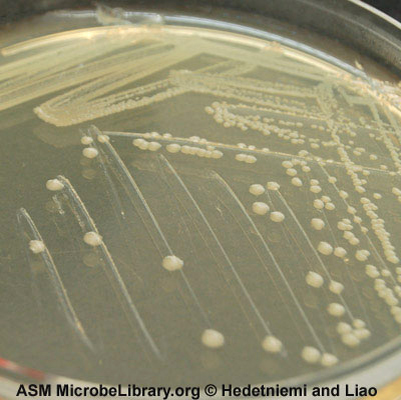2.6: Forms of Culture Media/Oxygen and Temperature Requirements
- Page ID
- 122948
1. Broth tubes are tubes containing a liquid medium. A typical nutrient containing broth medium such as Trypticase Soy broth contains substrates for microbial growth such as pancreatic digest of casein, papaic digest of soybean meal, sodium chloride, and water.
After incubation, growth (development of many cells from a few cells) may be observed as one or a combination of three forms:
a. Pellicle: A mass of organisms is floating on top of the broth (see Fig. \(\PageIndex{1B}\)).
b. Turbidity: The organisms appear as a general cloudiness throughout the broth (see Fig. \(\PageIndex{1C}\)).
c. Sediment: A mass of organisms appears as a deposit at the bottom of the tube (see Fig. \(\PageIndex{1D}\)).
|
Fig.\(\PageIndex{1B}\): Broth Culture Showing Pellicle |
Fig. \(\PageIndex{1C}\): Broth Culture Showing Turbidity |
Fig. \(\PageIndex{1D}\): Broth Culture Showing Sediment |
|---|---|---|
| (Copyright; Gary E. Kaiser, Ph.D. The Community College of Baltimore County, Catonsville Campus CC-BY-3.0) | ||
2. Slant tubes (see Fig. \(\PageIndex{2A}\))are tubes containing a nutrient medium plus a solidifying agent, agar-agar. The medium has been allowed to solidify at an angle in order to get a flat inoculating surface (see Fig. \(\PageIndex{2B}\)).
|
Fig. \(\PageIndex{2A}\): An Agar Slant Tube (Side View) |
Fig. \(\PageIndex{2B}\): An Agar Slant Culture |
|---|---|
| (Copyright; Gary E. Kaiser, Ph.D. The Community College of Baltimore County, Catonsville Campus CC-BY-3.0) | |
3. Stab tubes (deeps) are tubes of hardened agar medium which are inoculated by "stabbing" the inoculum into the agar (see Fig. \(\PageIndex{3}\)).
4. Agar plates are sterile petri plates that are aseptically filled with a melted sterile agar medium and allowed to solidify. Plates are much less confining than slants and stabs and are commonly used in the culturing, separating, and counting of microorganisms. Single colonies of microorganisms on agar plates can be described using the terms found in Appendix A.

C. OXYGEN REQUIREMENTS FOR MICROBIAL GROWTH
Microorganisms show a great deal of variation in their requirements for gaseous oxygen. Most can be placed in one of the following groups:
1. Obligate aerobes are organisms that grow only in the presence of oxygen. They obtain energy from aerobic respiration.
2. Microaerophiles are organisms that require a low concentration of oxygen for growth. They obtain energy from aerobic respiration.
3. Obligate anaerobes are organisms that grow only without oxygen and, in fact, oxygen inhibits or kills them. They obtain energy from anaerobic respiration or fermentation.
4. Aerotolerant anaerobes, like obligate anaerobes, cannot use oxygen for growth but they tolerate it fairly well. They obtain energy from fermentation.
5. Facultative anaerobes are organisms that grow with or without oxygen, but generally better with oxygen. They obtain energy from aerobic respiration, anaerobic respiration, and fermentation. Most bacteria are facultative anaerobes.
D. TEMPERATURE REQUIREMENTS
Microorganisms have a minimum and maximum temperature at which they can grow, as well as an optimum temperature where they grow best. Microorganisms can be divided into groups on the basis of their preferred range of temperature:
1. Psychrophiles are cold-loving bacteria. Their optimum growth temperature is between -5°C and 15°C. They are usually found in the Arctic and Antarctic regions and in streams fed by glaciers.
2. Mesophiles are bacteria that grow best at moderate temperatures. Their optimum growth temperature is between 25°C and 45°C. Most bacteria are mesophilic and include common soil bacteria and bacteria that live in and on the body.
3. Thermophiles are heat-loving bacteria. Their optimum growth temperature is between 45°C and 70°C and are commonly found in hot springs and in compost heaps.
4. Hyperthermophiles are bacteria that grow at very high temperatures. Their optimum growth temperature is between 70°C and 110°C. They are usually members of the Archae and are found growing near hydrothermal vents at great depths in the ocean.
Contributors and Attributions
Dr. Gary Kaiser (COMMUNITY COLLEGE OF BALTIMORE COUNTY, CATONSVILLE CAMPUS)

